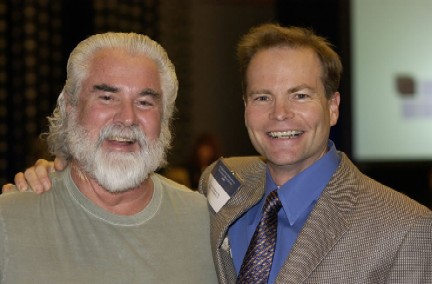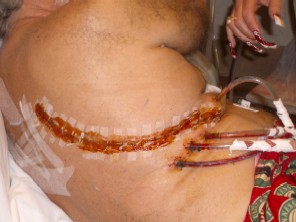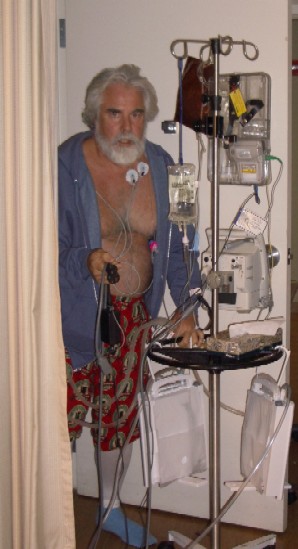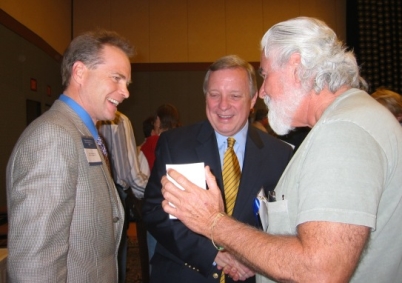Beating Mesothelioma For The Many Women In His Life
You instantly notice John McNamara when he walks into a room. A burly figure, with a grayish beard and ruddy cheeks, John is the spitting image of Kenny Rogers, the country western singer. Intimidating? Not a chance. More like charismatic. He's one of those guys you just know has a story and wants to tell it.
More often than not, his stories are about his wife and children. John and T.C. have been married for over thirty years.
AN UNTAMED SPIRIT
John is an active man who would never blink at a broken bone. In fact, he once broke his left leg in a skiing accident, and shortly thereafter, broke his right leg at work. While at work, John took the brace from his left leg and actually molded it to fit his right leg, setting the bone before driving himself to the hospital. When he got to the hospital, the doctors found that John had done such a good job setting the bone, that there was nothing more they could do! He's never been afraid of a little pain.
Although just shy of 60 years old, John was not ready to slow down. As a crane operator, he had no problem with climbing up tall tower cranes and nimbly maneuvering the booms and winches with the precision of a Swiss watchmaker. He was working steadily at his job until August 2005 when he began to have shortness of breath and pain in his lower back.
At first, John attributed his shortness of breath and cough to a simple cold virus. But the symptoms became serious enough to push John to visit the emergency room at Holy Cross Hospital in Mission Hills, California in early August 2005. At the hospital, chest films were taken that revealed fluid build up in his lung cavity. To relieve the pressure, the doctors performed a thoracentesis, withdrawing over one liter of pleural fluid. John recalls they used a big needle, and once the skin was punctured the fluid "started shooting out like a fire hose." The fluid was sent out for testing, and the results showed mesothelial and atypical cells, but it was not conclusively malignant. John's doctors kept him in the hospital for continued observation.
REJUVENATION IN A HAWAIIAN GETAWAY
The McNamaras had planned a family trip to Hawaii at the end of August. But, as the scheduled day of departure approached, John was laid up in a hospital. He was feeling better and growing restless. The doctors agreed to discharge him, and John spent the next month with his family on tropical shores. His trip was rejuvenating, and he only had occasional problems with breathing.
When the family returned to California the next month, John returned to Holy Cross Hospital for more testing. In September 2005, John underwent another thoracentesis where doctors removed two liters of fluid behind his right lung cavity. This time around, testing of the fluid returned a confirmed diagnosis of malignant pleural epithelial mesothelioma. His doctor painted a very bleak future coping with mesothelioma and wrongly gave him only a two-month prognosis. The only so-called advice offered by the uninformed doctor was to get busy doing the "five best things you ever wanted to do." John immediately replied that he just wanted to be with his family and live out life on his own terms. However, when it came down to it, John really wanted to fight for his life.
ASSEMBLING A TREATMENT PATHWAY
The McNamaras did not take this grim prediction lying down. For the next month, they searched high and low for doctors who had experience treating mesothelioma. Most of the doctors they talked to simply suggested chemotherapy. None offered any hope. John and T.C. did not accept the gloom and doom. Finally, T.C. found hope with Dr. Robert Cameron, the Chief of Thoracic Surgery at UCLA Medical School in Los Angeles, California.
They met Dr. Cameron in the fall of 2005 at the Mesothelioma Applied Research Foundation (MARF) symposium in Las Vegas, Nevada. They learned that Dr. Cameron's approach to surgery is far different than most. Instead of performing an extra-pleural pneumonectomy ("EPP"), a radical surgeryinvolving removal of the tumor along with all of the encased lung, the pleurectomy / decortication procedure ("P/D") that Dr. Cameron performs involves meticulously removing the tumor and leaving the lung intact. Dr. Cameron's procedure affords patients a much better post surgical quality of life and, when followed by radiation and immunotherapy, has produced median survival rates far in excess of that associated with the EPP procedure.
John was convinced that Dr. Cameron's plan afforded him the best opportunity for long term survival. Dr Cameron performed the P/D surgery in November, 2005. The procedure lasted approximately eight hours, far longer than the alternative EPP procedure, but Dr. Cameron was able to remove the tumor and leave John with the use of his right lung.
John's experience in the hospital after the surgery was challenging. John has never been able to lie on his back comfortably, and following surgery, he could not lie on his right side either because of all the protruding drainage tubes and surgical incisions. So John spent eleven days lying on his left side, trying to recuperate. He spent sleepless nights there, every breath painful with four chest tubes for seven days. Two tubes were removed on the seventh day and the other two removed on the tenth. As he started to recover from his surgery, however, John began to have atrial fibrillation or an abnormal heartbeat, which continued to keep him in the hospital. T.C. never left his side. Finally, after eleven days, the hospital released him to his family.
After he recovered sufficiently, John began radiation therapy which lasted from late January through mid March, 2006. Following radiation, he had another CT scan that revealed abnormalities in his right lung. Dr. Cameron attributed these abnormalities in part to surgery, radiation, and the tumor itself.
Two months later in May, John embarked on the next phase of treatment. He began taking low doses of interferon to help bulk up his own immune system to combat the mesothelioma. Interferon is a relatively new treatment option for mesothelioma patients, but has shown good results for some patients.
However, after administering the interferon for one month, John's shortness of breath grew worse. By the middle of June 2006, he decided to discontinue the interferon medication. According to Dr. Cameron, increased shortness of breath is a rare side effect of the interferon treatment that occurs with some patients.
John discussed future treatment options with Dr. Cameron, including the benefits and drawbacks of chemotherapy. Ultimately, John decided against it. Since June 2006, the only treatments he takes are painkillers to help soothe any soreness in his chest.
LIFE AFTER SURGERY
Even though the surgery went well, John was distraught physically from residual pain and medicinal side effects. He had to take so many drugs (just in the first month he worked down from three pills every three hours to one pill every five hours) that he became nervous about how the medicine was affecting him.
In the months following his surgery, John found it difficult not to partake in all of the physical activities he shared with his young daughters prior to his diagnosis. But, instead of lying on the couch and feeling sorry for himself while life passed him by, John began going on walks with his girls, first around a local shopping mall, then, when he could make it up the stairs, he joined them on hikes in the trails around their home, eventually making it to the top of the notorious look-out hill.
John showing Roger Worthington (l) and Senator Dick Durbin recent photographs of him climbing a mountain in Hawaii, post-surgery at the 2006 MARF Symposium in Chicago, Illinois held in October, 2006
In August of 2006, John decided to take his family back to Hawaii for another family vacation. Perhaps the trip was just what John needed because he found that he was able to enjoy walking on the beach and even a little climbing. John felt a special sense of accomplishment when he hiked with his daughters to the top of Diamond Head. John proudly boasts that he passed many other hikers on the way up and celebrated with a "Rocky Balboa-like" victory dance at the top.
It's no secret that John attributes much of the success he has experienced to date in his battle against mesothelioma to the work of Dr. Cameron. On August 4, 2006, John had a follow up visit with Dr. Cameron, and a PET/CT scan of his chest, abdomen, and pelvis on September 29, 2006. Results from these scans indicated a possible recurrence of the tumor. Dr. Cameron advised John that another PET/CT scan is needed as well as another bronchoscopy to determine the disease's progression.\
Even through this, John has not lost hope; he continues to live every day fully. He returned again to the third annual Mesothelioma Applied Research Foundation symposium during October 2006 in Chicago, Illinois. At the symposium John shared his story. He spoke about pain, about the support of family, and of finding the best medical treatment available. He even shared a picture taken of his victory dance atop Diamond Head Mountainwith the other attendees, including Senator Dick Durbin who spoke about the need for asbestos reform and mesothelioma funding.
John has not stopped fighting and continues to share his story along the way.

John McNamara and Roger Worthington, October, 2006
*** POSTED NOVEMBER 27, 2006 ***
Mr. John McNamara passed away on October 8, 2007





